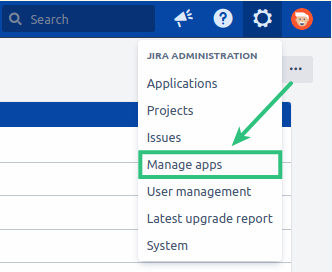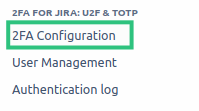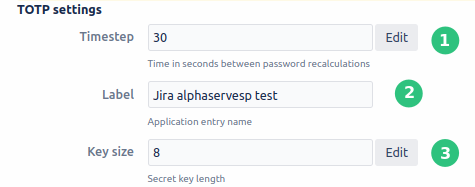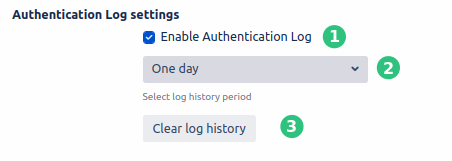| Table of Contents | ||||||||||||
|---|---|---|---|---|---|---|---|---|---|---|---|---|
|
How to configure 2FA for Jira: U2F & TOTP?
Note! U2F devices work only with a secure HTTPS connection. If you want to use U2F devices, make sure that your instance is already using it.
Step 1. Go to the Jira Administration tab and select Manage app section.
Step 2. On the left side menu panel find 2FA FOR JIRA: U2F & TOTP tab and click 2FA Configuration.
2FA configuration page
Below you will find a detailed description of 2FA configuration:
TOTP settings:
1. Timestep is the interval in seconds between the previous and the new generation of the PIN code. By default, all Authenticators use 30 seconds. Change it only if you are using your own Authenticator with a different value.
2. Label will be displayed by the mobile Authenticator as an identifier for the underlying Atlassian application
3. Key size is the length of the generated secret key (needed for TOTP algorithm). By default, all Authenticators use 8. Change it only if you are using your own Authenticator with a different value.
WebAuthn General Settings
1. WebAuthn Relying Parties use Attestation Type to specify their preference regarding attestation conveyance during credential generation.
“None” - this value indicates that the Relying Party is not interested in authenticator attestation. For example, in order to potentially avoid having to obtain user consent to relay identifying information to the Relying Party, or to save a roundtrip to an Attestation CA.
“Indirect” - this value indicates that the Relying Party prefers an attestation conveyance yielding verifiable attestation statements, but allows the client to decide how to obtain such attestation statements. The client MAY replace the authenticator-generated attestation statements with attestation statements generated by an Anonymization CA, in order to protect the user’s privacy, or to assist Relying Parties with attestation verification in a heterogeneous ecosystem.
“Direct” - This value indicates that the Relying Party wants to receive the attestation statement as generated by the authenticator.
2. Authenticator Type makes further restrictions on the type of authenticators allowed for registration
“Platform” - this value indicates platform attachment. A platform authenticator is attached using a client device-specific transport, called platform attachment, and is usually not removable from the client device. A public key credential bound to a platform authenticator is called a platform credential.
“Cross-platform” - this value indicates cross-platform attachment. A roaming authenticator is attached using cross-platform transports, called cross-platform attachment. Authenticators of this class are removable from, and can "roam" among client devices. A public key credential bound to a roaming authenticator is called a roaming credential.
WebAuthn Advanced Settings
1. User Verification requires user verification for the login and registration operations.
“Required” - this value indicates that the Relying Party requires user verification for the operation and will fail the operation if the response does not have the UV flag set.
“Preferred” - this value indicates that the Relying Party prefers user verification for the operation if possible, but will not fail the operation if the response does not have the UV flag set.
“Discouraged” - this value indicates that the Relying Party does not want user verification employed during the operation (e.g., in the interest of minimizing disruption to the user interaction flow).
2. Register with Resident Key allows to login by proving a local PIN on the device.
Permission settings
To be able to administrative 2FA for Jira: U2F & TOTP should grant permission to change the plugin settings.
These settings grant users and groups permission.
Force settings
1. None -if you choose this option, 2FA will not be compulsory for Jira users. If you need to make it compulsory - use others below.
2. All -it’s compulsory for all users.
3. Groups - it’s compulsory only for selected groups of users.
4. All except groups - this option allows you to choose а certain group of Jira users who will be able to log in to the Jira without using the second authentication factor when all other users will be forced to use application.
5. A special field for entering the list of groups separated by commas. Example "jira-administrators, jira-users".
IP whitelist settings
1. Mark the checkbox Enable IP whitelist to enable whitelist of IP addresses that pass without a 2FA check.
2. IP configuration - enter the desired IP address.
3. Enter the IP comment to recognize the IP address from the list (not required).
4. Applies to:
All - if the user’s IPs are retrieved from all IP headers.
LAN - if the user’s internal IPs are retrieved from headers.
5. Click Add filter button to add IP to whitelist.
![]() You can find more information about IP whitelist settings here!
You can find more information about IP whitelist settings here!
Relative URLs whitelist settings
Enter the relative URLs of other plugins, it allows you to access them without a second authentication factor.
![]() Please note: Each URL should be a separate row.
Please note: Each URL should be a separate row.
Authentication Log settings
1. Mark the checkbox Enable authentication log to allow logging all action with 2FA For example: adding or remove the device, log it into the system with Authenticator or U2F device.
2. If you want to clear the logs select the retention period and click the Clear logs button.
3. Clear log history. One-time deletes the log history except for the retention period.
After log history clearing all-new authentication logs will be saved in the application regardless of the selected log history period until you clear it again.
![]() You can find more information about Authentication Log here!
You can find more information about Authentication Log here!
"Remember me" settings
1. Enable "Remember me" feature checkbox. This option will allow end-users to use “Remember me” feature on Login Screen and ignore Second Factor Authentication.
![]() Please note: This feature will be useful if during the day you often log out and log in to Jira, but you have to make sure that using this feature complies with the security requirements in your company.
Please note: This feature will be useful if during the day you often log out and log in to Jira, but you have to make sure that using this feature complies with the security requirements in your company.
2. Set the desired session expiry in hours (max number is 336 hours).
Brute Force settings
1. Enable Brute Force Protection. This will lock out a user for a specified amount of time if that user generates the specified number of login failures.
2. Number of Attempts - specified number of login failures after which user will be locked out.
3. Lockout Period - a specific amount of time during which the user will be locked out.
Plugin settings
1. Reset to defaults. This action will restore plugin settings to defaults and delete users' authentication settings.
2. Mark the checkbox Enable U2F devices to turn on the U2F device for login.
3. Mark the checkbox Enable Duo Security Support to enable support for Duo Authenticator.
Note: Enabling DUO support allows users to successfully apply valid TOTP code from the DUO mobile app and avoid ‘Authentication failed’ message.
4. Mark the checkbox Enable OAuth whitelist to allow execute requests using OAuth and ignore Second Factor Authentication.
5. Mark the checkbox REST API restriction to turn on and restrict all REST requests for users with enabled 2fa.
6. Mark Enable Auto Submit on Login Form to torn on auto submit the form without clicking the Submit button.
7. Mark the checkbox Hide "Deactivate 2FA Protection" button. This option will notallow disabling 2FA protection for non-admin users for their accounts.
8. Mark the checkbox Hide the "2FA Configuration" button from the Service Desk. If this option enabled, the button will be hidden from the user profile panel for everyone in Service Desk.
9. Click the Save button to save the configuration.
2FA Users
| Status | ||||
|---|---|---|---|---|
|
This setting allows you to view all users and filter users without enabled 2FA.
Being signed in to you Jira account, select ⚙️ (the Gear icon), and then select Manage apps.
Select 2FA Users.
| Info |
|---|
Here, you can see all users: active and inactive. |
Select Only active users to view users with enabled 2FA.
Select Only inactive users to view users without enabled 2FA.
















